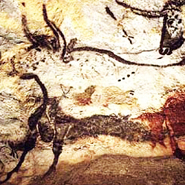Posted 16 February 2010
Scientists unpick genetic code of extinct giant cattle
Scientists have determined the first mitochondrial DNA genome sequence from extinct giant cattle (aurochs), according to findings published in the scientific journal Plos ONE. Mitochondrial DNA (mtDNA) is passed down from a mother to her offspring.
Following this discovery, the scientists claim to be able to sequence the complete DNA genome of the aurochs within the next 12 months.
Aurochs are famously featured in the ancient cave paintings at Lascaux, France. They were much larger and more aggressive than their modern descendents.
Standing over six feet tall to the shoulder and weighing more than a ton, aurochs were giant wild cattle that roamed the plains of Europe for thousands of years.
European domestic cattle are thought to have descended from aurochs that were domesticated at the dawn of agriculture in the region of the Near East known as the Fertile Crescent. The last recorded aurochs died in Poland in 1627.
“Our results demonstrate the incredible promise that next-generation DNA sequencing holds for archaeogenetics,” says Professor David MacHugh from the Animal Genomics Laboratory and Conway Institute at University College Dublin where the DNA sequencing was conducted.
“Once we complete the full nuclear genome sequencing, we can compare the DNA of the aurochs with that of modern domesticated cattle to identify genes associated with improved health, production and behavioural traits which have evolved since cattle were first domesticated almost 10,000 years ago,” he explains.
The team of scientists from University College Dublin, Trinity College Dublin, Oxford University, the University of Sheffield, and the University of Leeds, analysed DNA extracted from a well preserved aurochs leg bone discovered in a cave in Derbyshire, England. The bone is radiocarbon-dated as being approximately 6,500 years old.
“The bone is exceptionally well preserved due to its deposition in a cave system with a stable ambient temperature,” says the papers co-author Dr Ceiridwen Edwards from Oxford University and formerly of Trinity College Dublin’s School of Genetics and Microbiology where she conducted the initial research. “It has consistently yielded high-quality DNA.”
“We are within a year of sequencing the complete DNA genome of this extinct animal. All this has only recently become possible through new technologies which allow us to sequence billions of base pairs of DNA in a relatively short time,” adds Professor MacHugh.
The University College Dublin scientists and their colleagues at Trinity College Dublin, Oxford University, the Universities of Sheffield and Leeds have recently started to collaborate with researchers at the United States Department of Agriculture’s Agricultural Research Service, Beltsville (USDA-ARS Beltsville) to sequence and assemble a complete aurochs nuclear genome sequence within the next 12 months.
The PLoS ONE paper is available online:
The research and paper published in PLoS ONE is the result of an Irish-UK collaboration led by Professor David MacHugh at the Animal Genomics Laboratory, University College Dublin, but also involving scientists based at Trinity College Dublin, the University of Oxford, the University of Sheffield and the University of Leeds.
The paper describes the generation and analysis of a complete aurochs mitochondrial genome (16,338 base pairs) produced using both massively-parallel high-throughput ‘next-generation’ DNA sequencing (Illumina Genome Analyzer) and the older Sanger method for DNA sequencing.
The mitochondrion is the cellular organelle responsible for energy production via aerobic respiration, and possesses a circular DNA genome separate from the much larger nuclear genome. The mitochondrion originally evolved more than 1.5 billion years ago from free-living primitive bacteria through a process known as endosymbiosis.
The auroch’s humerus bone was recovered from a cave site located in Derbyshire, England, and radiocarbon-dated to 6,738 ± 68 years before present. The bone pre-dates the advent of archaeologically-documented animal agriculture in Britain by more than 1,000 years. The bone is exceptionally well-preserved, due to its deposition in a cave system with a stable ambient temperature, and it has consistently yielded high-quality DNA.
(Produced by UCD University Relations)

